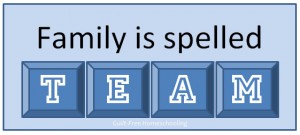Do you realize that the mental skill used in sorting army men from building blocks is the same mental skill used in sorting variables in algebra problems? Makes higher math a little less scary, doesn’t it?
When a child can recognize and organize a playroom floor full of toys, he is honing the same skill he will use years later in recognizing and organizing an equation full of x’s, y’s, and xy’s. Whether the army men are green or tan, they are all considered army men, and building blocks are building blocks, regardless of their color. Whether the math variable is 2x or 3x, it is still considered an x-quantity. Army men do not get stored with building blocks, and x’s do not get combined with y’s.
If children are old enough to play with toys, they are old enough to put those toys away again. We used shoeboxes and plastic ice cream buckets large enough to hold all the army men or all the building blocks. Long before reading skills were acquired, I drew picture labels on index cards and taped them to each container (nothing fancy, just rough, cartoon-style illustrations — no words). Each child also had a picture chart for how to clean his room: a drawing of a messy bed and an arrow pointing to a drawing of a made-up bed; a drawing of books on the floor and an arrow pointing to a drawing of books on the shelf; a drawing of clothes in a pile on the floor and an arrow pointing to a drawing of the hamper. You get the idea. So will your kids. The artistically-challenged can adapt the idea with photos or pictures cut from magazines or catalogs.
The skill of tidying up the play area is extremely valuable, both to children and to parents. The children will grow in confidence and courage as they realize they have a new skill. Obviously, the parents will appreciate any amount of help in clearing a path through the house. However, do not expect your tiny tykes to understand this endeavor the first time you spring it on them, and do not expect them to do a first-class, absolutely perfect job… ever (hence the need for containers roomy enough to easily fit the contents). To begin with, sit on the floor with your little darlings and challenge them to pick out all of one specific type of toy from the jumble on the floor and put them into their container while you dispatch all of the other toys to their assigned spots. Point out to them how it is simpler to pick out the largest pieces first, before trying to select the tiniest pieces. Eventually, your little helper will be able to tackle two or three types of toys, one after the other. After they have mastered their sorting skills, you will notice them sorting out several different types of toys at the same time, as you would. Be sure to point out their progress and praise them for it.
Make your pick-up time fun by challenging each other to races or by sliding the Matchbox cars down a strip of racetrack into their storage box. Always allow for clean-up time as a part of playtime, so that no one is caught by surprise, and you are not left to clean up the mess after everyone else is tucked into bed. I did not want to make pick-up time feel like a punishment to be dreaded, so I helped my children as they learned the task and praised them for the good jobs they were doing. I have always enjoyed having someone to talk to while I clean up my kitchen, so I could easily understand why my children wanted my company while picking up their toys. “Together-time” with your children is never wasted time.
Another reward for a job well done was permission to play with more than one board game at a time. When I was a child, my mother had a strict rule that one game or puzzle had to be completely picked up and put away before a second one could be brought out. My children’s success at efficiently sorting and storing won them the privilege of playing with more than one thing at a time — which their creative minds took to new heights as they invented ways of combining games. They found it as much fun to sort out the pieces from multiple games, as it had been to play with the games themselves. Plus, you can only have enough letter tiles to solve some word puzzles when you combine the tiles from Scrabble, Scrabble Junior, and Upwords along with the anagram tiles!
I began teaching this sorting task to my children when they were very small — toddlers, in fact — years before we began homeschooling. I did not actually see the connection to higher math until years later. My children had no difficulty with understanding the concepts of polynomials (xy-type variables, for those of you who have forgotten or not reached that point yet in your homeschool), due in great part, I feel, to the sorting skills they possessed.
We held a birthday party for my daughter at age 15 and invited a handful of her homeschool peers. One of the games we had prepared was a jigsaw puzzle challenge. Each team of 2 girls was given a bag of jigsaw puzzle pieces: 3 puzzles combined — all simple, elementary level puzzles of varying size and complexity, but with all their pieces combined. The challenge was to separate the puzzles and reassemble all 3 puzzles before the other teams completed theirs. I was amazed at how difficult this was for some of the girls. Even though the puzzles were easily separated by the size of their pieces, some of the players had extreme difficulty in recognizing that. None of the puzzles contained more than 100 pieces, and each one was very simple to distinguish from the others and put together. As I later analyzed this situation in regard to the families involved, I concluded that the players who had the most difficulty came from families where Overworked Mom did all the picking up.
We should never feel that teaching our children to do household cleaning tasks is a punishment for them — it is giving them a future, valuable, life skill. In this particular case, they will learn recognition, sorting, and organization — skills valuable for their further education, as well as being beneficial for personal and professional choices they will make later in their lives. Learning to sort toys is learning to prioritize.
[See also The Importance of Play in Education]





 Guilt-Free Homeschooling is the creation of Carolyn Morrison and her daughter, Jennifer Leonhard. After serious disappointments with public school, Carolyn spent the next 11 years homeschooling her two children, from elementary to high school graduation and college admission. Refusing to force new homeschooling families to re-invent the wheel, Carolyn and Jennifer now share their encouragement, support, tips, and tricks, filling their blog with "all the answers we were looking for as a new-to-homeschooling family" and making this website a valuable resource for parents, not just a daily journal. Guilt-Free Homeschooling -- Equipping Parents for Homeschooling Success!
Guilt-Free Homeschooling is the creation of Carolyn Morrison and her daughter, Jennifer Leonhard. After serious disappointments with public school, Carolyn spent the next 11 years homeschooling her two children, from elementary to high school graduation and college admission. Refusing to force new homeschooling families to re-invent the wheel, Carolyn and Jennifer now share their encouragement, support, tips, and tricks, filling their blog with "all the answers we were looking for as a new-to-homeschooling family" and making this website a valuable resource for parents, not just a daily journal. Guilt-Free Homeschooling -- Equipping Parents for Homeschooling Success!

Recent Comments